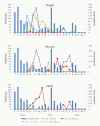Abundance and dynamics of anopheline larvae in a highland malarious area of south-central Ethiopia
- PMID: 22695178
- PMCID: PMC3414819
- DOI: 10.1186/1756-3305-5-117
Abundance and dynamics of anopheline larvae in a highland malarious area of south-central Ethiopia
Abstract
Background: Malaria is a public health problem in Ethiopia, and increasingly so in highland areas, possibly because of global warming. This study describes the distribution, breeding habitat and monthly dynamics of anopheline larvae in Butajira, a highland area in south-central Ethiopia.
Methods: A study of the abundance and dynamics of Anopheles larvae was undertaken at different sites and altitudes in Butajira from July 2008 to June 2010. The sites included Hobe (1817 m.a.s.l), Dirama (1995m.a.s.l.) and Wurib (2196m.a.s.l.). Potential anopheline larval habitats were surveyed once per month in each village. The recorded characteristics of the habitats included habitat type, pH, surface debris, emergent plants, algae, substrate, turbidity, temperature, length, width, depth, distance to the nearest house and anophelines. The Spearman correlation coefficient and Mann-Whitney U test were used to calculate the degree of association between the density of anopheline species and key environmental factors.
Results: Among the different types of habitat surveyed, the Odamo, Akamuja and Assas streams and Beko swamp were positive for anopheline larvae. A total of 3,957 third and fourth instar larvae were collected from the three localities, and they represented ten species of anophelines. These were: Anopheles cinereus (32.5%), An. arabiensis (31.4%), An. chrysti (23%), An. demeilloni (12.2%), An. pretoriensis (0.6%), An. azaniae (0.1%), An. rufipes(0.1%), An. sergentii (0.06%), An. garnhami (0.06%) and An. pharoensis (0.03%). The density of anopheline larvae was highest during the dry months. An. arabiensis was widely distributed, and its density decreased from the lowest elevation in Hobe to the highest in Wurib. The density of An. arabiensis larvae was correlated positively with larval habitat temperature (r = 0.33, p < 0.05) and negatively with depth of larval habitat (r = -0.56, p < 0.05).
Conclusion: Ten species of anophelines were identified, including two known vectors of malaria (An. arabiensis and An. pharoensis), along streams in Butajira. Larvae of An. arabiensis were found in streams at 2200 m.a.s.l. This possible expansion of the malaria vector to highland areas indicates an increasing risk of malaria because a large proportion of the Ethiopian population live above this altitude.
Figures
Similar articles
-
Comparative entomological study on ecology and behaviour of Anopheles mosquitoes in highland and lowland localities of Derashe District, southern Ethiopia.Parasit Vectors. 2014 Oct 20;7:483. doi: 10.1186/s13071-014-0483-9. Parasit Vectors. 2014. PMID: 25326716 Free PMC article.
-
Blood meal sources and entomological inoculation rates of anophelines along a highland altitudinal transect in south-central Ethiopia.Malar J. 2013 Feb 23;12:76. doi: 10.1186/1475-2875-12-76. Malar J. 2013. PMID: 23433348 Free PMC article.
-
Anopheles larval species composition and characterization of breeding habitats in two localities in the Ghibe River Basin, southwestern Ethiopia.Malar J. 2020 Feb 11;19(1):65. doi: 10.1186/s12936-020-3145-8. Malar J. 2020. PMID: 32046734 Free PMC article.
-
Environmental factors associated with larval habitats of anopheline mosquitoes (Diptera: Culicidae) in irrigation and major drainage areas in the middle course of the Rift Valley, central Ethiopia.J Vector Borne Dis. 2011 Jun;48(2):85-92. J Vector Borne Dis. 2011. PMID: 21715730
-
Study on the species composition and ecology of anophelines in Addis Zemen, South Gondar, Ethiopia.Parasit Vectors. 2018 Mar 27;11(1):215. doi: 10.1186/s13071-018-2701-3. Parasit Vectors. 2018. PMID: 29587821 Free PMC article.
Cited by
-
Effect of LongRange™ eprinomectin on Anopheles arabiensis by feeding on calves treated with the drug.Malar J. 2019 Sep 30;18(1):332. doi: 10.1186/s12936-019-2964-y. Malar J. 2019. PMID: 31564253 Free PMC article.
-
Population Movement as a Risk Factor for Malaria Infection in High-Altitude Villages of Tahtay-Maychew District, Tigray, Northern Ethiopia: A Case-Control Study.Am J Trop Med Hyg. 2017 Sep;97(3):726-732. doi: 10.4269/ajtmh.17-0129. Epub 2017 Jul 19. Am J Trop Med Hyg. 2017. PMID: 28722582 Free PMC article.
-
Comparative entomological study on ecology and behaviour of Anopheles mosquitoes in highland and lowland localities of Derashe District, southern Ethiopia.Parasit Vectors. 2014 Oct 20;7:483. doi: 10.1186/s13071-014-0483-9. Parasit Vectors. 2014. PMID: 25326716 Free PMC article.
-
Blood meal sources and entomological inoculation rates of anophelines along a highland altitudinal transect in south-central Ethiopia.Malar J. 2013 Feb 23;12:76. doi: 10.1186/1475-2875-12-76. Malar J. 2013. PMID: 23433348 Free PMC article.
-
Use of epidemiological and entomological tools in the control and elimination of malaria in Ethiopia.Malar J. 2018 Jan 12;17(1):26. doi: 10.1186/s12936-018-2172-1. Malar J. 2018. PMID: 29329545 Free PMC article. Review.
References
-
- MoH Federal Democratic Ethiopia. National Five-Year Strategic Plan for Malaria Prevention and Control in Ethiopia. Addis Ababa, Ethiopia; 2006.
-
- Graves PM, Richards FO, Ngondi J, Emerson PM, Shargie EB, Endeshaw T, Ceccato P, Ejigsemahu Y, Mosher AW, Hailemariam A, Zerihun M, Teferi T, Ayele B, Mesele A, Yohannes G, Tilahun A, Gebre T. Individual, household and environmental risk factors for malaria infection in Amhara, Oromia and SNNP regions of Ethiopia. Trans R Soc Trop Med Hyg. 2009;103:1211–1220. doi: 10.1016/j.trstmh.2008.11.016. - DOI - PubMed
-
- White GB, Tessfaye F, Boreham PFL, Lemma G. Malaria vector capacity ofAnopheles arabiensisandAn. quadriannulatusin Ethiopia: chromosomal interpretation after 6 years storage of field preparations. Trans R Soc Trop Med Hyg. 1980;74:683–684.
MeSH terms
LinkOut - more resources
Full Text Sources
Medical



